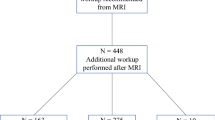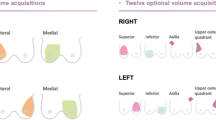Abstract
Purpose of Review
This article addresses the complexities involved in targeted ultrasound for lesions identified in mammograms and MRIs. We aim to provide clarity and guidance in performing targeted ultrasound by utilizing simple schematics and adopting a case-based approach.
Recent Findings
Targeted ultrasound is a vital component of diagnostic breast imaging, particularly for nonpalpable abnormalities detected on mammograms. In addition, with the increasing use of MRI in high-risk screening and staging breast cancer, second-look ultrasound is increasingly employed to evaluate incidental findings from MRI and guide tissue sampling, offering cost, availability, and patient comfort advantages. While the accuracy and technical aspects of second-look ultrasound for MRI-detected enhancements have been extensively examined, less attention has been given to targeted ultrasound for mammographically detected lesions.
Accurately targeting nonpalpable lesions presents challenges due to the differences in patient positioning and breast compression between mammography, MRI, and ultrasound. Mental fallacies, mainly caused by the non-orthogonal tube angling in mammography, can cloud judgment and impact targeting accuracy.
Summary
This article provides forthright explanations and practical solutions for accurately targeted ultrasounds on nonpalpable lesions found in mammograms and MRIs. It utilizes diagrams and everyday case examples to illustrate the concepts effectively. The goal is to offer practical solutions that can be readily applied in real-world scenarios.

















Similar content being viewed by others
Data Availability
No datasets were generated or analyzed during the current study.
References
Papers of particular interest, published recently, have been highlighted as: ∙Of importance
Abe H, Schmidt RA, Shah RN, Shimauchi A, Kulkarni K, Sennett CA, et al. MR-directed (“Second-Look”) ultrasound examination for breast lesions detected initially on MRI: MR and sonographic findings. Am J Roentgenol. 2010;194(2):370–7.
Spick C, Baltzer PAT. Diagnostic utility of second-look US for breast lesions identified at MR imaging: systematic review and meta-analysis. Radiology. 2014;273(2):401–9.
Bumberger A, Clauser P, Kolta M, Kapetas P, Bernathova M, Helbich TH, et al. Can we predict lesion detection rates in second-look ultrasound of MRI-detected breast lesions? A systematic analysis. Eur J Radiol. 2019;113:96–100.
∙Izumori A, Kokubu Y, Sato K, Gomi N, Morizono H, Sakai T, et al. The usefulness of second-look ultrasonography using anatomical breast structures as indicators for magnetic resonance imaging-detected breast abnormalities. Breast Cancer. 2020;27(1):129–39. This study illustrates the importance of using internal landmarks when correlating lesions between different imaging modalities.
∙Ziada K, Siu M, Qassid O, Krupa J. A new scoring system for differentiating malignant from benign “second-look” breast lesions detected by MRI in patients with known breast cancer. Clinical radiology. 2023;78(8):e560-e7. This study shows that second look ultrasound can in fact improve lesion characterization.
Telegrafo M, Rella L, Stabile Ianora AA, Angelelli G, Moschetta M. Supine breast US: how to correlate breast lesions from prone MRI. Br J Radiol. 2016;89(1059):20150497.
∙Goto M, Nakano S, Saito M, Banno H, Ito Y, Ido M, et al. Evaluation of an MRI/US fusion technique for the detection of non-mass enhancement of breast lesions detected by MRI yet occult on conventional B-mode second-look US. Journal of Medical Ultrasonics. 2022;49(2):269–78. This study shows the difficulty of locating non-mass enhancements on second look ultrasound.
Miyake T, Shimazu K. Third-look contrast-enhanced ultrasonography plus needle biopsy for differential diagnosis of magnetic resonance imaging-only detected breast lesions. J Med Ultrason (2001). https://doi.org/10.1007/s10396-023-01298-8
∙Jeon T, Kim YS, Son HM, Lee SE. Tips for finding magnetic resonance imaging-detected suspicious breast lesions using second-look ultrasonography: a pictorial essay. Ultrasonography. 2022;41(3):624. This study gives practical tips for breast imagers to locate enhancing lesions detected in MRI using ultrasound.
Cardenosa G. Breast imaging companion. Lippincott Williams & Wilkins; 2011.
Ikeda D, Miyake KK. Breast imaging: the requisites E-book. Elsevier Health Sciences. 2016;12:130.
Baker JA, Lo JY. Breast tomosynthesis: state-of-the-art and review of the literature. Acad Radiol. 2011;18(10):1298–310.
Gil BM, Jung NY, Kim SH, Kang BJ, Lee J, Chung MH. Value of shear wave elastography during second-look breast ultrasonography for suspicious lesions on magnetic resonance imaging. J Med Ultrason. 2022;49(4):719–30.
Kolta M, Clauser P, Kapetas P, Bernathova M, Pinker K, Helbich TH, et al. Can second-look ultrasound downgrade MRI-detected lesions? A retrospective study. Eur J Radiol. 2020;127: 108976.
Hellerhoff K, Dietrich H, Schinner R, Rjosk-Dendorfer D, Sztrókay-Gaul A, Reiser M, et al. Assessment of MRI-detected breast lesions: a benign correlate on second-look ultrasound can safely exclude malignancy. Breast Care. 2021;16(5):435–43.
Izumori A, Kokubu Y. Ultrasound diagnosis of non-mass MRI-detected lesions. J Med Ultrason. 2023;50(3):351–60.
Huang J, Lin Q, Cui C, Fei J, Su X, Li L, et al. Correlation between imaging features and molecular subtypes of breast cancer in young women (≤30 years old). Jpn J Radiol. 2020;38(11):1062–74.
Author information
Authors and Affiliations
Contributions
Dr. Sefidbakht and Ataee contributed the patients, Dr. Sefidbakht designed the schematics; All authors contributed in study design, drafting the manuscript, and reviewing the final article.
Corresponding author
Ethics declarations
Competing interests
The authors declare no competing interests.
Ethical Approval
This article does not contain any studies with human or animal subjects performed by any of the authors.
Additional information
Publisher's Note
Springer Nature remains neutral with regard to jurisdictional claims in published maps and institutional affiliations.
This article is part of the Topical collection on Breast Imaging.
Supplementary Information
Below is the link to the electronic supplementary material.
Supplementary file1 (MP4 5677 kb)
Supplementary file2 (MP4 2030 kb)
Rights and permissions
Springer Nature or its licensor (e.g. a society or other partner) holds exclusive rights to this article under a publishing agreement with the author(s) or other rightsholder(s); author self-archiving of the accepted manuscript version of this article is solely governed by the terms of such publishing agreement and applicable law.
About this article
Cite this article
Sefidbakht, S., Pishdad, P., Ataei, L. et al. Efficient Strategies for Targeted and Second-Look Ultrasound: Enhancing Visualization and Simplifying Techniques. Curr Radiol Rep 12, 51–64 (2024). https://doi.org/10.1007/s40134-024-00426-7
Accepted:
Published:
Issue Date:
DOI: https://doi.org/10.1007/s40134-024-00426-7




